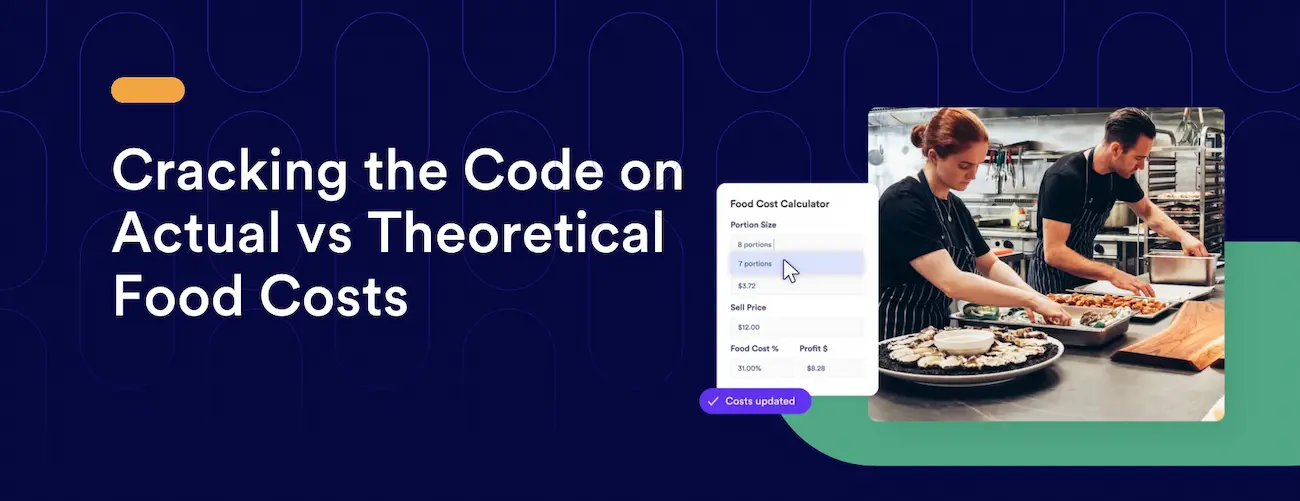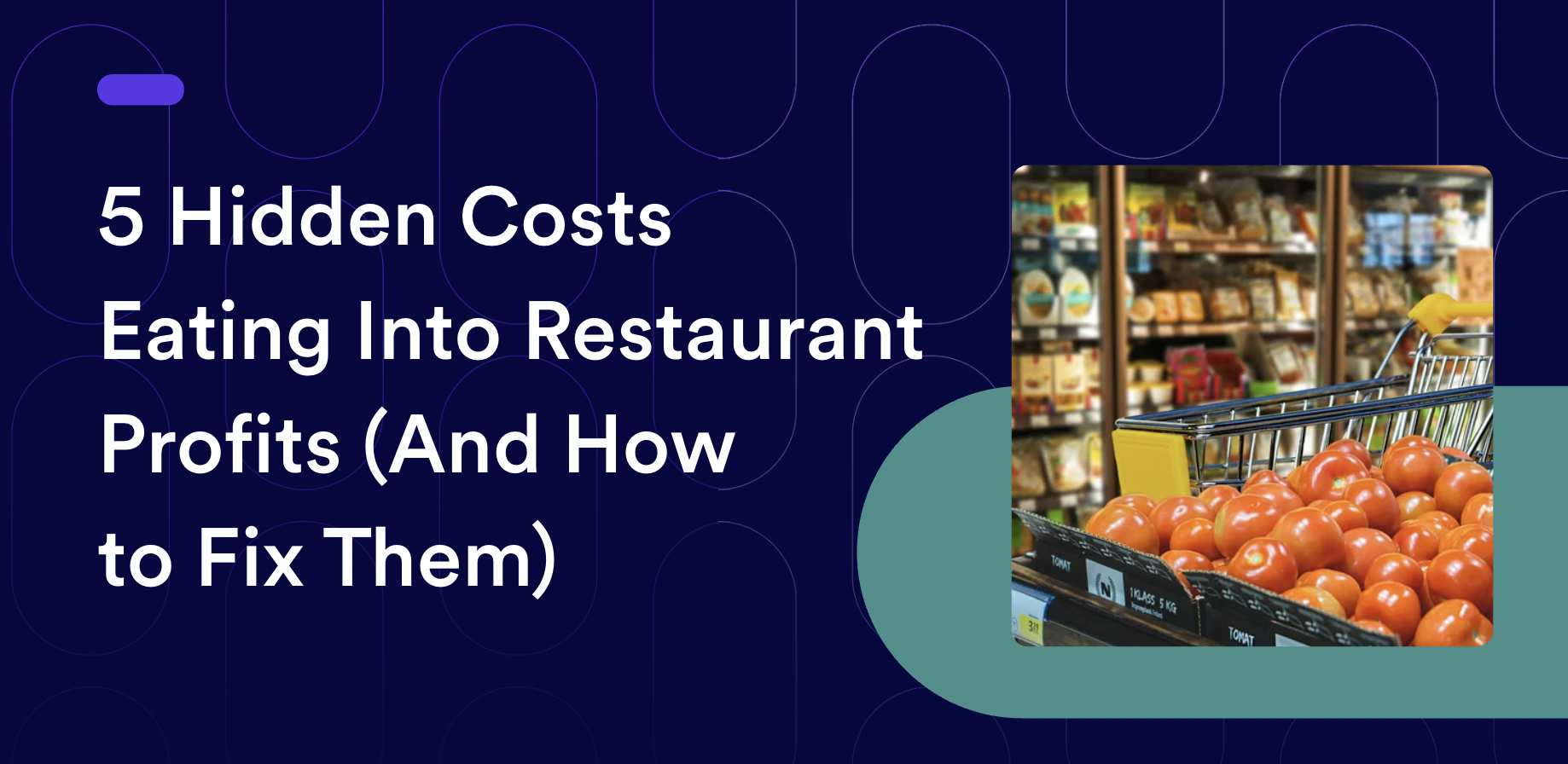Managing a restaurant is a balancing act of creativity, precision, and financial acumen. One crucial aspect that often puzzles even the most seasoned restaurateurs and chefs is managing food costs.
Today, we'll dive deep into this topic and show how meez software can be your secret weapon in understanding the difference between actual and theoretical food costs.
What’s the Difference Between Actual vs Theoretical?
Actual Food Costs
Actual food costs refer to the real expenses incurred in purchasing, preparing, and serving food. This includes everything from the price of raw ingredients to waste and spoilage. Think of it as the money that physically leaves your cash register and goes toward keeping your kitchen stocked.
Theoretical Food Costs
Theoretical food costs, on the other hand, are the ideal expenses you should incur based on your recipes, portion sizes, and menu pricing. These costs are calculated under the assumption that everything runs perfectly—no waste, no spoilage, and precise portion control.
Bridging the Gap
The goal is to minimize the gap between actual and theoretical food costs. While achieving a perfect match is nearly impossible due to various uncontrollable factors, understanding this variance can guide you in making strategic decisions to optimize your restaurant's profitability.
Determining Actual vs. Theoretical Food Costs
Step-by-Step Calculation
- Gather Data: Collect data on all ingredients, their costs, and the quantities used in your recipes.
- Calculate Theoretical Costs: Use your recipe data to compute the ideal cost for a given period.
- Track Actual Expenses: Record all food-related expenses during the same period.
- Compare and Analyze: Subtract the theoretical cost from the actual cost to find the variance. Analyze the reasons for this difference.
Practical Example
Let’s say your restaurant’s theoretical cost for a dish is $8 based on ideal ingredient usage and portion sizes. However, at the end of the month, you find that the actual cost is $10. This $2 difference might seem small, but if you’re selling 1,000 units of this dish, that’s a $2,000 loss!
Conducting regular audits can help you stay on top of these variances and take corrective actions promptly.
What are Profit Leaks?
Profit leaks in restaurants, particularly when analyzing actual versus theoretical food costs, refer to the discrepancies between the ideal (theoretical) food costs and the actual costs incurred. These leaks indicate inefficiencies, waste, or losses that impact the restaurant's profitability.
Here are some common sources of profit leaks in this context:
Waste and Spoilage
- Over-portioning: When kitchen staff serve more food than the portion size specified in the recipe, it results in higher food costs. This can happen due to lack of training or inadequate measuring tools. To address this, training staff on precise portion control is essential. Using standardized scoops and portion control tools can help ensure consistency.
- Improper Storage: Incorrect storage conditions, such as incorrect temperatures or humidity levels, can lead to food spoilage. This includes not rotating stock correctly, leading to older items being forgotten and expiring. Implementing strict storage protocols, like FIFO (First In, First Out), can help. Regularly checking storage equipment for correct functioning is also crucial.
- Poor Inventory Management: Not keeping accurate records of inventory can lead to over-ordering or under-utilizing existing stock, causing wastage. A robust inventory management system can help track what’s in stock, what’s needed, and what’s close to expiry, thereby reducing unnecessary waste.
Theft and Pilferage
- Employee Theft: Unfortunately, employee theft can occur, ranging from consuming food without permission to taking ingredients for personal use. Installing security cameras in storage areas, conducting regular inventory audits, and creating a culture of accountability can help mitigate this.
- Dishonest Suppliers: Suppliers might deliver less than what is billed or charge for higher-quality goods than delivered. Regularly auditing supplier deliveries, cross-checking invoices with received goods, and maintaining good relationships with reliable suppliers can prevent such issues.
Inefficient Preparation
- Untrained Staff: Staff who are not well-trained may make errors in food preparation, leading to waste. For example, overcooking or incorrectly cutting ingredients can lead to wastage. Comprehensive training programs and detailed recipe cards can help ensure staff are preparing food correctly.
- Inefficient Kitchen Processes: Disorganized kitchen processes can result in higher ingredient usage. Streamlining kitchen workflows, ensuring each station is well-stocked and organized, and regularly reviewing kitchen procedures can improve efficiency.
Menu Design and Engineering
- Unpopular Menu Items: Items that are rarely ordered can lead to waste of specific ingredients. Regularly analyzing sales data to identify and remove or revise underperforming menu items can reduce this waste.
- Complex Recipes: Recipes with many ingredients or intricate steps can increase the likelihood of errors and waste. Simplifying recipes without compromising quality can help reduce this issue. Additionally, using versatile ingredients across multiple dishes can minimize waste.
Supplier Issues
- Price Fluctuations: Unexpected increases in ingredient costs can affect food costs. Developing strong relationships with multiple suppliers can provide more stable pricing and flexibility. Additionally, negotiating fixed-term contracts can help manage costs.
- Quality Inconsistencies: Inconsistent ingredient quality can lead to higher usage as more of the ingredient is needed to maintain dish standards. Ensuring suppliers adhere to quality standards and regularly inspecting deliveries can help mitigate this.
Incorrect Pricing
- Underpricing Menu Items: Failing to account for the actual food costs when pricing menu items can erode profit margins. Regularly reviewing and updating menu prices to reflect current food costs ensures that the restaurant maintains profitability.
- Failing to Update Prices: Ingredient costs can change over time, and if menu prices are not adjusted accordingly, profit margins will suffer. Implementing a periodic review of costs and pricing can help keep prices in line with costs.
Inaccurate Record Keeping
- Errors in Inventory Counts: Incorrect inventory counts can lead to misleading food cost calculations. Implementing a robust inventory management system that includes regular physical counts and reconciliations can ensure accurate data.
- Inaccurate Sales Data: Misrecorded sales data can lead to flawed cost analysis. Ensuring that point-of-sale systems are properly configured and staff are trained to use them correctly can provide accurate sales data for analysis.
How to Address Profit Leaks
- Regular Audits: Conducting regular audits of inventory, sales, and food preparation processes can identify discrepancies early. These audits can highlight areas where actual costs deviate from theoretical costs, allowing for prompt corrective actions.
- Staff Training: Ongoing training for staff on portion control, efficient preparation techniques, and waste reduction is vital. Well-trained staff are less likely to make costly mistakes.
- Inventory Management: Implementing strict inventory management practices, such as using inventory management software, can provide real-time tracking and control over stock levels, reducing waste and theft.
- Menu Optimization: Regularly reviewing and updating the menu based on sales data and cost analysis can help optimize the use of ingredients and ensure pricing is appropriate. Removing low-performing items and focusing on popular, profitable dishes can improve margins.
- Supplier Management: Building strong relationships with suppliers and regularly reviewing their performance and prices ensures consistent quality and cost. Comparing prices and negotiating terms can also lead to better deals.
- Use Technology: Adopting advanced point-of-sale (POS) systems integrated with inventory management software provides real-time data on sales and inventory, helping to identify discrepancies and manage costs effectively.
- Standardize Recipes: Developing and enforcing standardized recipes ensures consistency in portion sizes and ingredient use, reducing variability and waste. Recipe management software can help maintain consistency across the kitchen.
- Monitor and Analyze Data: Continuously monitoring actual versus theoretical food costs and analyzing discrepancies is crucial. Using data analytics tools can provide insights into where leaks are occurring and how to address them.
- Implementing Standard Operating Procedures: Standard operating procedures (SOPs) for tasks like inventory management, food storage, and preparation can help maintain consistency and reduce errors. Make sure these SOPs are well-documented and easily accessible to your staff.
Future Trends in Food Cost Management
AI and Machine Learning
Artificial intelligence and machine learning are set to revolutionize food cost management. These technologies can predict trends, optimize inventory levels, and even suggest menu changes based on customer preferences.
Sustainable Practices
As sustainability becomes a priority, restaurants are looking for ways to reduce waste and source ingredients responsibly. Implementing sustainable practices can not only reduce costs but also attract environmentally conscious customers.
Blockchain Technology
Blockchain technology offers transparency and traceability in the supply chain. This can help restaurants ensure the quality and authenticity of their ingredients, reducing the risk of fraud and improving customer trust.
How meez Helps
meez’s recipe management software can significantly enhance theoretical food costing for restaurants by providing precise and organized recipe data. It allows chefs to input detailed ingredient information, portion sizes, and preparation steps, ensuring consistency across all dishes. Plus, it automatically calculates the cost of each recipe based on ingredient prices, helping restaurants maintain accurate and up-to-date theoretical food costs.
This streamlined approach not only aids in identifying discrepancies between actual and theoretical costs but also assists in menu engineering, pricing decisions, and inventory management, ultimately reducing waste and improving profitability.
- Accurate Food Costing: meez offers laser-accurate food costing by utilizing over 2,500 system ingredients with built-in yield, prep loss, and conversions. This ensures that your theoretical costs are as accurate as possible, providing a solid benchmark for comparison.
- Real-Time Cost Updates: With meez, you can connect invoices to products and update costs in real time. This helps keep your actual costs in check and allows for immediate adjustments in case of price fluctuations.
- Standardize Recipes: meez helps you standardize your recipes by allowing you to upload photos, PDFs, and even copy-paste from existing documents. This ensures consistency in portion sizes and ingredient usage, reducing variance between actual and theoretical costs.
- Train Staff Efficiently: Offer comprehensive digital recipe training with meez. Visually guide your team through dish prep, recipe execution, and plating with photos and videos. This ensures every detail is followed, minimizing errors and waste.
- Monitor Menu Mix: Analyze the cost and value of any menu, from a la carte to tasting menus, cocktails, and catering. Determine which items drive the most profit and sales volume while identifying outliers. See how updates to recipes, sell price, and portion sizes impact menu cost, profit, and revenue.
- Profitability Insights: meez provides analytics to identify areas for improvement. Know which ingredients are costing you the most, make proactive adjustments, and always have an eye on your menu’s top money-makers and low-profit dishes.
Conclusion
Understanding the difference between actual and theoretical food costs is crucial for any restaurant aiming to maximize its profitability. By leveraging tools like meez and adopting best practices for food cost management, you can minimize waste, optimize inventory, and enhance your bottom line.
Remember, the key to success lies in continuous improvement and staying abreast of industry trends. Embrace technology, train your staff, and always look for ways to refine your processes. Your efforts will not only improve your financial performance but also elevate the overall dining experience for your customers.
Ready to take your food cost management to the next level? Explore how meez can help you achieve your goals and ensure the long-term success of your restaurant.







